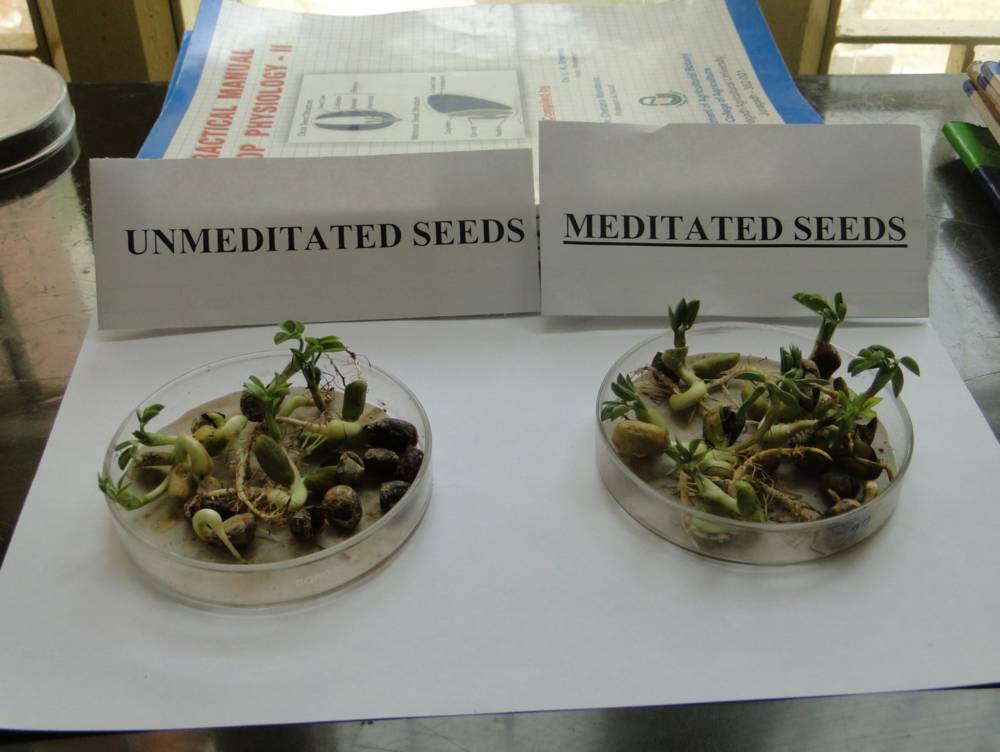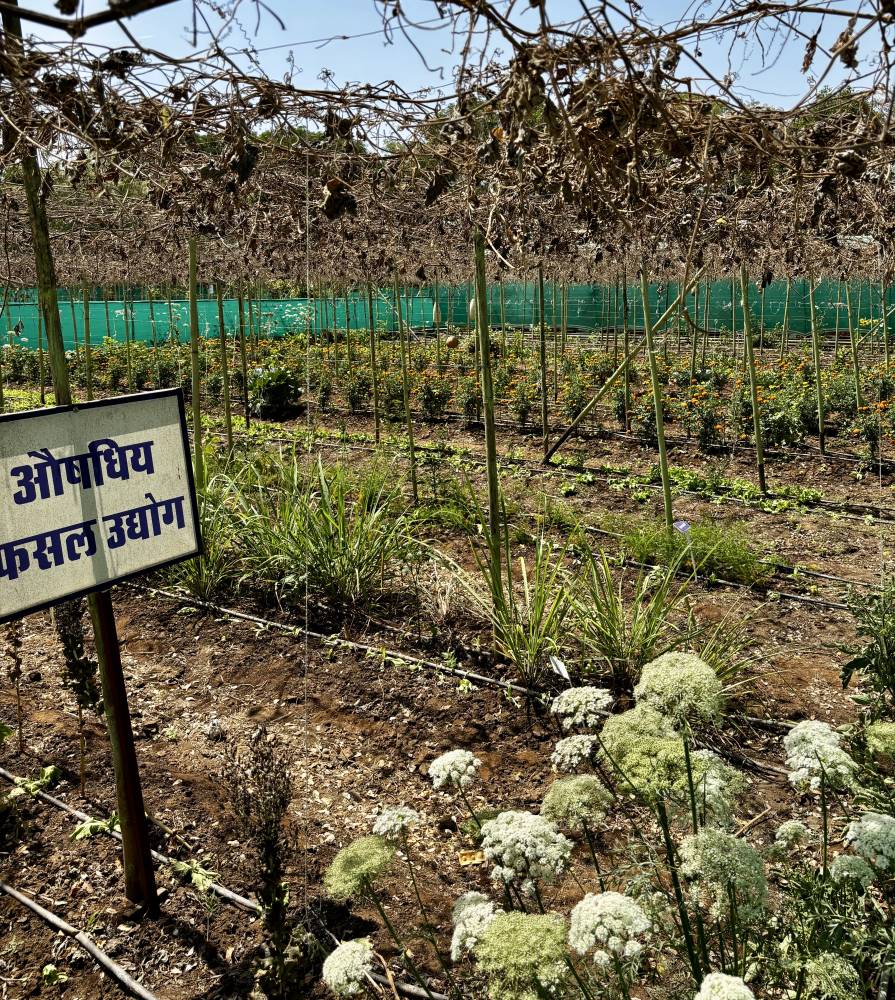In India, confident, happier farmers grow better crops

Sustainable Yogic Agriculture (SYA), a unique method originating in India, integrates meditation with natural farming practices to improve the financial stability and overall well-being of small-scale farmers. Developed by the Agriculture and Rural Development Wing of the Brahma Kumaris, this approach combines spiritual empowerment techniques with a comprehensive view of agriculture, encompassing soil health and the broader environment.
The SYA involves farmers engaging in raja yoga meditation to positively influence their seeds and enhance their personal lives. It also incorporates traditional agricultural methods such as on-farm production of cow-based resources, crop rotation, and natural pest management. Indian farmers who have adopted a vegetarian lifestyle and ethical animal care practices within this framework have reported positive transformations.
The Brahma Kumaris (BK), an organization with ties to the United Nations, has increasingly focused on climate change, emphasizing the strong connection between human actions and environmental degradation. The organization posits that negativities such as greed and ego have fueled unsustainable development over the past two centuries, leading to widespread social, economic, and ecological crises. The SYA offers a straightforward yet impactful solution by addressing the core values and mindset of farmers.
In the past two decades, over 2,000 farmers across India have collaborated with agricultural scientists and universities to implement the SYA. The process includes placing seeds at the raja yoga meditation center, where practitioners focus positive intentions, such as peace and love, and the union with the Supreme on them for up to a month before planting. Farmers also participate in regular meditation sessions in their fields or homes twice daily. The program extends meditation practices to various stages of the farming cycle. Initial findings suggest significant improvements in both the quality and quantity of harvested crops.

Better yield
BK Sumanth, the headquarters coordinator for the Agriculture and Rural Development Wing of the BK Raja Yoga Education and Research Foundation, notes that after observing improved yields and disease resistance, farmers began using raja yoga meditation as a primary tool for managing agricultural challenges, reducing their reliance on chemicals. “The consistent meditation practice throughout the growing season has proven effective,” Sumanth explains.
Raja yoga meditation complements a shift towards natural farming methods, which Sumanth distinguishes from organic farming. Natural farming, he clarifies, prioritizes complete self-sufficiency at the farm level. Farmers generate all necessary inputs, including fertilizers and pest control solutions, using resources available directly on their land. This contrasts with organic farming, which, while avoiding synthetic chemicals, may still involve sourcing natural inputs from outside suppliers.
A crucial element of natural farming within the SYA is the on-site preparation of natural fertilizers and pest repellents. Examples include neem oil, extracted from local neem trees, and diluted cow urine, both used for natural crop protection. Farmers also develop various natural tonics to enhance plant health and preservation. Unlike the controlled environment of vermiculture in some organic systems, earthworms in SYA-aligned natural farming thrive freely in the soil, contributing to its health through natural processes.
The emphasis on self-reliance extends to seed management. While acknowledging the initial need to acquire or purchase high-quality, locally adapted seeds, the SYA encourages farmers to eventually cultivate and save their own seeds. This practice is seen as important to lowering expenses, as seed costs often constitute a substantial portion of a farmer’s investment.
Sumanth elaborates, “The return to natural farming highlights the interconnectedness within the farm ecosystem. Farmers understand the need to restore soil health and the natural balance that has been disrupted by decades of chemical use.”
The SYA movement’s roots trace back to 2003 in Maharashtra, India. A raja yoga practitioner envisioned a systematic application of meditation to agriculture, beginning with a collaborative effort with two farmers in their sugarcane fields. This initial work expanded to involve university research.
Sumanth recalls their approach to an agricultural university in Gujarat. “Initially, the scientists were reluctant, viewing meditation and agricultural research as separate fields. However, their perspective shifted upon examining seed germination. After ‘priming’ the seeds through raja yoga meditation, the university’s analysis proved a 78 percent improvement in germination rates.”
Following this success, the Brahma Kumaris launched a campaign in 2007 to promote SYA across Indian villages. Many farmers have since visited the Tapovan Farm at the BK headquarters in Mount Abu, Rajasthan, to learn more.
Building farmers’ confidence
To convince the farmers to adopt this new farming method, Sumanth focuses on building their confidence. He points out their vital role in conserving agriculture, preserving biodiversity, and contributing to global health by producing nutritious food. He frames the farmer’s responsibility as similar to a mother’s, capable of providing either nourishment or harm. Farmers, he says have the power to choose healthy production and revitalize agriculture and biodiversity.
Findings from Maharashtra farms indicate that SYA, combining natural fertilizers and meditation, significantly increases beneficial soil microbes, which enhance soil productivity. This healthier soil leads to seeds sprouting up to a week earlier compared to conventional organic and chemical farming without meditation.
Subsequent harvests from SYA farms show higher levels of essential nutrients such as iron, energy, protein, and vitamins compared to crops grown using only natural fertilizers or chemicals. For instance, tomatoes cultivated using SYA methods showed the highest Vitamin C content. Economically, SYA has proven beneficial, saving farmers approximately Rupees 14,769 ($330 USD) per acre compared to chemical farming, offering a low-cost, high-benefit approach.
Many farmer testimonies support these findings. One banana farm involved in SYA experienced less impact from an unusual drought compared to neighboring chemically managed farms, demonstrating better water retention. In another instance, yogic sugarcane grown using SYA possessed a distinct and superior taste compared to chemically grown sugarcane. Moreover, during flooding, SYA sugarcane remained upright while chemically grown crops flattened.
In a case of severe mealy bug infestation in a SYA sugarcane field, instead of pesticides, focused raja yoga meditation by the farmer and his sister for two days eradicated the pests, saving the majority of the crop while neighboring farms suffered significant losses.
“In the end,” Sumanth concludes, “meditation fosters a natural balance in our lives, mirroring its effect on the soil, plant life, and nutrition within the ecosystem. It yields wonderful results, enriching every facet of life.”
Visit the website, eco.brahmakumaris.org or www.brahmakumaris.org/environment-initiatives, or contact B.K. Sumanth at tel. no. (+91) 75975 46732. Learn raja yoga meditation for free at the Brahma Kumaris Center Makati, at tel. no. 8890-7960.

















